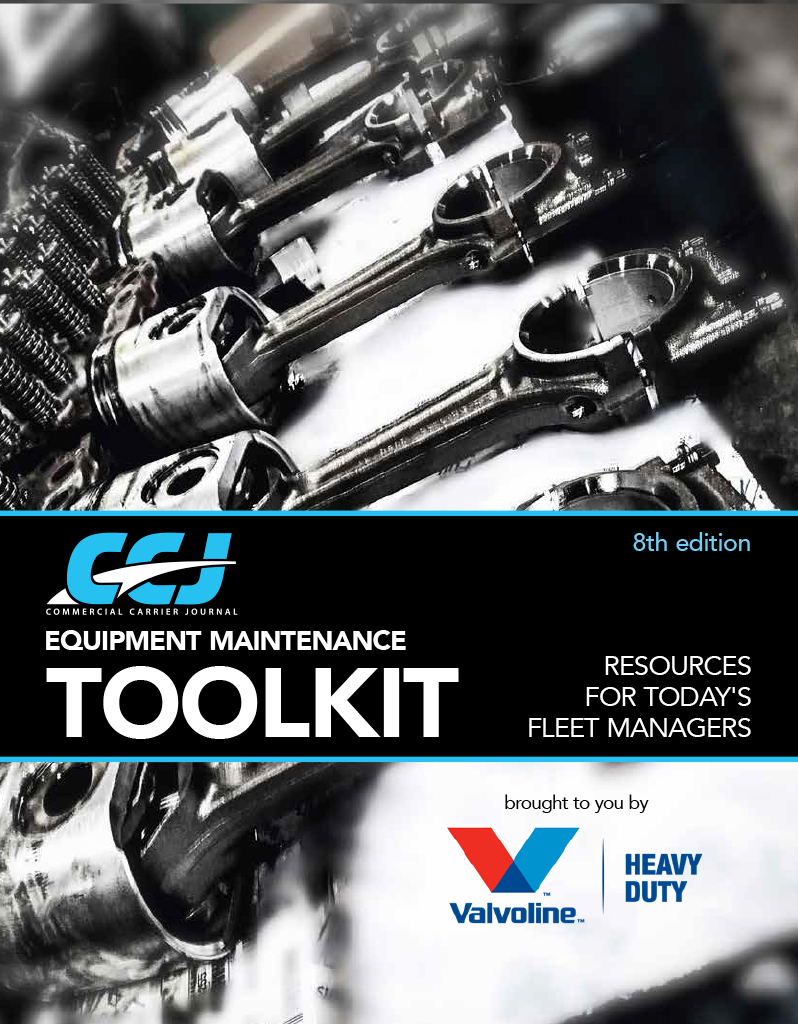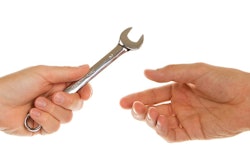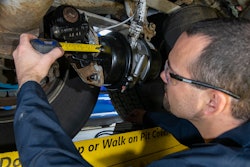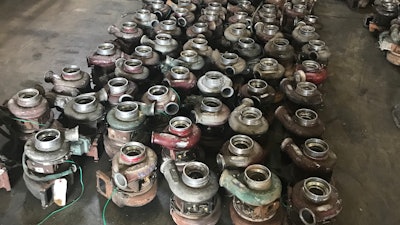
The following was published in CCJ's Equipment Maintenance Toolkit, 8th edition, sponsored by Valvoline Heavy Duty. CCJ's Equipment Maintenance Toolkit is a complementary industry resource, courtesy of our partnership with Valvoline Heavy Duty. You can download the entire Toolkit here.
Sometimes a truck will come into the shop with the owner claiming there’s something wrong with the turbocharger. While that might be true, it’s also very possible the turbo was an innocent victim and there’s alternative reasons why the turbo has gone bad.
Download CCJ's Equipment Maintenance Toolkit
CCJ’s Equipment Maintenance Toolkit is one of the most comprehensive publications that CCJ publishes to assist fleet maintenance managers and individuals responsible for commercial vehicle maintenance and equipment purchasing.
Brought to you by Valvoline, CCJ’s Equipment Maintenance Toolkit offers useful information for fleet maintenance managers, including:
- The business of truck maintenance
- Vehicle maintenance
- Maintenance technology
- Parts organization and inventory management
- Transmission maintenance
- Resources and references
John Ferry, executive vice president, Turbo Solutions, says turbochargers have been a hot topic in service shops for more than 10 years and there is still an education process occurring in the industry. Ferry says when mandates to reduce greenhouse gas emissions and improve fuel economy standards were put in place, turbochargers got “rolled up into that.” Simple turbos became more complex variable geometry turbos (VGT) costing six times more than their predecessors.
Service providers quick to swap out a turbocharger without inspecting other systems stand a good chance of seeing an unhappy customer in a few months grumbling about the same problem.
“Everybody must understand the turbocharger is a component in a complicated system and if you do have a problem, you want to make sure the other components are properly working and are properly maintained,” Ferry says.
Peter Ventress, senior service engineer with Cummins’ turbocharger business, adds, “Turbochargers are precision machines and they have a rotor system that can spin up to 200,000 rpms, depending on the size of the turbo. So when things go wrong, they tend to go wrong quickly. However, the turbo is designed to operate for the full life of the engine.”
Though a technician might be tempted to head directly for the turbocharger, Ventress says a thorough examination of an entire engine should be completed first. Understanding a turbo failure requires identifying and eliminating its root cause.
When checking an engine, Ventress says technicians should inspect all pipework and clamps, oil and water lines, the aftertreatment system, the quality of oil as well as the oil and air filters and, if it’s an electrical turbocharger, check the electrical connections for damage. Also, all connections should be tight because “we don’t want leaks of oil, exhaust gas, air or coolant,” he says.
One of the common problems is [OEMs] get turbochargers back and there’s nothing wrong with them.
“We get the same thing. It’s called misdiagnosis,” Ferry says. “If you have a problem in the systems and you don’t have any power going to the engine and the first thing you do as a reflex is pull the turbo and change it, there’s a good chance you’re still going to have the same problem. So what do they do, they take their chances and send it back for warranty. That’s a big problem also.”
Indications and possible causes
There are signs to watch — and listen — for to help determine whether a turbocharger is damaged and what might have caused it. Among the litany of warning signs (see chart from Turbo Solutions) when troubleshooting potential turbocharger issues, experts say a handful come up most often.
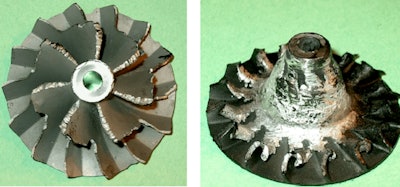 Severe compressor wheel damage caused by a foreign object in the turbocharger. Source: BorgWarner
Severe compressor wheel damage caused by a foreign object in the turbocharger. Source: BorgWarner
One is a loss of power, whether it be enough torque to get their load moving or enough horsepower to achieve the cruising speed they want, says Tim Golema, MAHLE senior technical sales specialist.
“The reality is it may not be the turbocharger at all. It could be the lack of air and as simple as an air cleaner but they’re likely going to blame the turbocharger,” Golema says.
In addition to a dirty air filter, other culprits include collapsed upstream ducting restricting air to the compressor or a restriction in the exhaust system, such as a clogged catalytic converter, says Seth Temple, senior application engineer, BorgWarner. “High exhaust restriction can cause a loss of power,” he adds.
Another sign to consider is an acoustic noise or a change in the sound the turbocharger is making.
“For example, if a turbo is out of balance, it will make a different sound or if a turbo has been damaged and a blade has been chipped, that can change the pitch a turbo is intended to produce,” Temple says.
Insufficient oil can cause the turbocharger to heat up, creating a different sound, says Golema, who advises to check for an obstruction to the turbo’s oil supply.
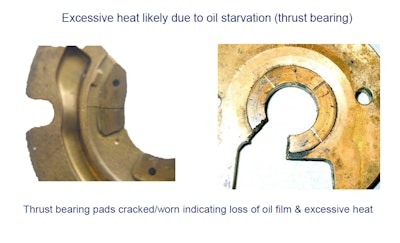 BorgWarner
BorgWarner
Although listening to the turbocharger can provide a technician with leads to finding the problem, Golema says detecting a turbo problem by sound can be a tricky proposition.
“Noise is one way to identify an issue but you have to detect a strange pitch. You could be thinking it’s turbocharger noise when it’s belt noise, the air conditioning compressor or some other system on the truck,” he says.
Smoke, the color and location of it, also are clues to what could be causing issues with the turbocharger or a problem with another part of the truck.
A very common sign, says Golema, is “black stack,” which is black smoke coming from the exhaust. Two potential causes are the fuel condition is too rich or the turbocharger is inefficient.
If the fuel is running rich, the turbo is not producing the airflow to maintain the correct air-to-fuel ratio, Temple says.
“You have to determine why it doesn’t have the air. Is there something leaking on the turbine side so it doesn’t have enough power to drive the compressor or is the compressor damaged? Is the turbo operating correctly but it can’t get the air into the turbo because the air filter is clogged?” Temple says.
Blue smoke from the tailpipe could be an oil leak on the compressor side of the turbocharger. Other reasons for blue smoke include dirty air filter system, clogged, leaking or distorted crankcase ventilation or coke and sludge in the turbocharger center housing, among other possibilities.
If smoke is coming from under the hood, a reason could be an oil leak at the turbine end of the turbocharger caused by a restricted oil drain or excessive blow-by, Temple adds.
Turbochargers are very susceptible to soot and foreign object impact damage (FOID), experts say. It’s a big issue and comes in many forms.
For example, if the diesel particulate filter — and the aftertreatment system, in general — aren’t properly working or maintained, back pressure is created and soot will build up inside the turbocharger. The soot can prevent the vanes inside the turbo from opening and closing, Ferry says.
“If you have a bad [exhaust gas recirculation] valve that gets all carboned up, little pieces of carbon can break off and go through the turbocharger. If you have any kind of metal, dust or carbon going through, it’s going to prematurely kill the VGT turbo,” he says.
Temple adds, “Aftertreatment is designed to work with the turbo. It does not extend the life of a turbo. If anything it can strain the turbo more but it’s part of the system to meet emissions.”
Inspecting the turbocharger
Because turbochargers are expected to last the life of the engine, inspecting the inside of the turbocharger reveals damage as well as clues to what could be causing it.
The first step, Ferry says, is to determine whether the problem is with the turbocharger or the electronic actuator. A code on the dash will tell the operator there is an issue with the actuator, but that might not be the case.
Many technicians will immediately replace the actuator only to find out their problem isn’t solved. By removing the actuator, technicians can check the VGT lever, which moves up and down. If it doesn’t move freely, the issue is with the turbo and possibly the actuator. If the lever does move freely, the turbo is fine, he says.
Ventress advises to inspect the rotor to ensure it can spin freely by hand. He also suggests moving the rotor system by hand axially and radially. If it touches the housing, the bearings likely are worn.
If the turbo has been oversped or a lot of contaminated oil has run through it, it will start wearing on the bearings and the typical clearances for end (or axial) play and radial play will allow a turbo to go beyond proper specifications, Temple says. It’s also important to check the compressor and turbine wheels have not been damaged by foreign objects entering into the turbocharger, he adds.
 BorgWarner
BorgWarner
Checking the compressor and turbine for any dirt, oil or sludge in the housing could bind the turbocharger. “That would indicate probably a problem with inlets, filtration or the engine itself if it’s putting out lots of soot. You would need to take the turbo off and clean it or replace it,” Ventress says.
Turbocharger TLC
The most important ways to keep a turbocharger healthy and performing as it should revolves around lubrication, filters and routine maintenance, experts say.
In addition to oil contaminated by coolant or diesel fuel, for example, Ferry says oil starvation caused by a faulty supply line can kill a turbo. “If that supply line is not getting enough oil to the turbo, you risk burning out the turbo within three seconds,” he adds.
Also, be sure aftertreatment components are maintained on the service interval that’s recommended by the OEM, “If you’re not doing that, you’re going to have components in the engine aftertreatment affect the life of the turbo. That’s the real knowledge that needs to get out there,” Ferry says.
Golema echoes Ferry’s sentiments regarding oil. “Use the correct factory-recommended OEM oil. And make sure you change all fuel, air and oil filters at prescribed intervals. Do those two things and you’ll be pretty safe with the engine and turbocharger,” he says.
Additionally, Ventress points out crankcase ventilation affects the turbocharger, so keeping the crankcase ventilation system — filters and pipes — clean and clear will greatly assist the turbo’s ability to seal oil in the turbo bearing housing. A common cause of oil leakage from the turbocharger is high crankcase pressure from poor ventilation.
He adds, “Maintaining the engine properly will safeguard the turbocharger, and it’s really important [technicians] and end users stick to the engine OEM service intervals with genuine parts when possible.”

